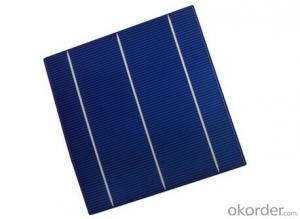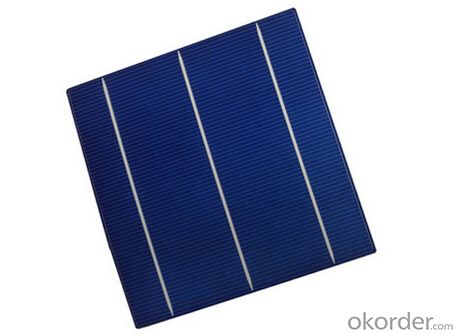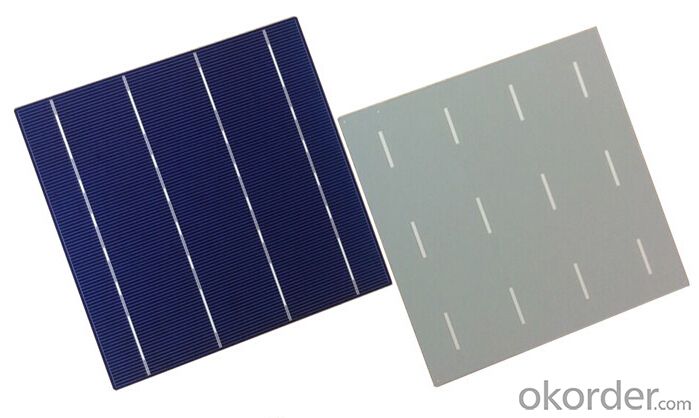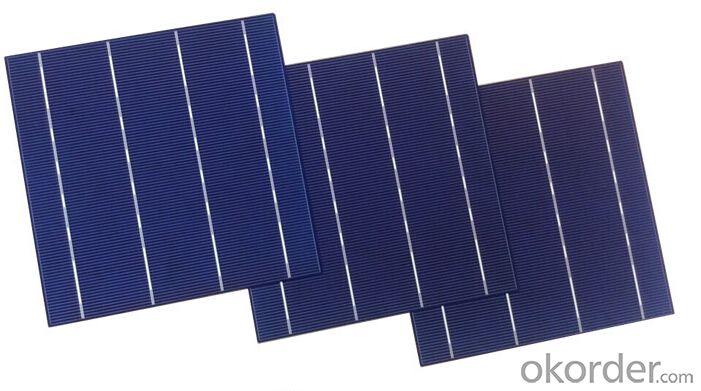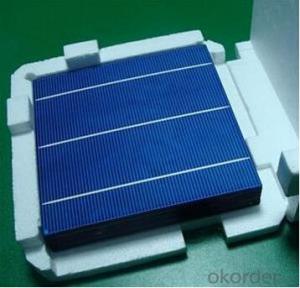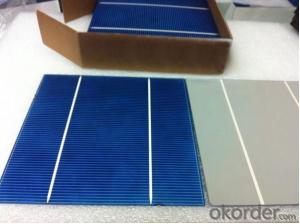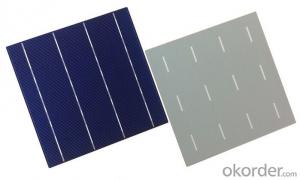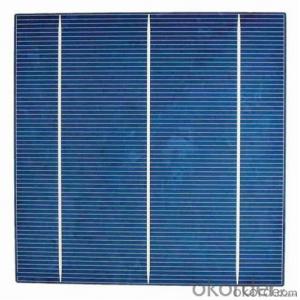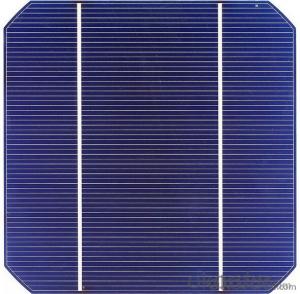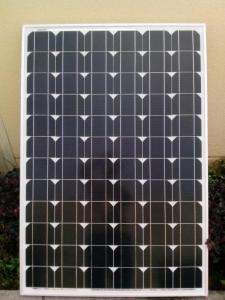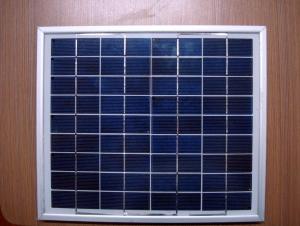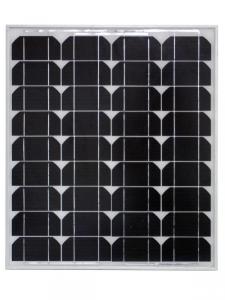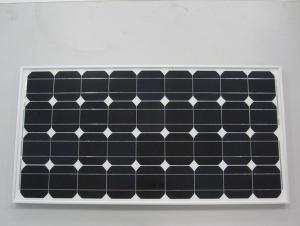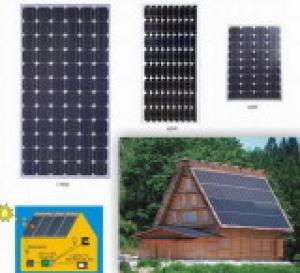High Efficiency Solar Panels - A Grade and B Grade 3BB & 4BB Solar Cells by USA Solar Panels Manufacturers
- Loading Port:
- Shanghai
- Payment Terms:
- TT OR LC
- Min Order Qty:
- 10000 watt
- Supply Capability:
- 100000000 watt/month
OKorder Service Pledge
OKorder Financial Service
You Might Also Like
Specification
1.Product Description:
Specifications of Poly Solar Cells
Dimension | 156mm X 156 mm ±0.5mm |
Wafer Thickness | 200um ±30um |
Front(-) | Four 1.1mm wide bus bars(silver) with distance 39mm, Acid texturized surface with blue silicon nitride AR coating. |
Back(+) | 2.4mm wide silver/aluminum soldering pads, aluminum back surface field. |
Temperature Coefficient of Poly Cells
Voc.Temp .coef.%/K | -0.351%/K |
Isc.Temp .coef.%/K | +0.035%/K |
Pm.Temp. coef.%/K | -0.47%/K |
Electrical Characteristic of Poly Cells
Efficiency code | 1720 | 1740 | 1760 | 1780 | 1820 | 1840 | |
Efficiency (min) | (%) | 17.2 | 17.4 | 17.6 | 17.8 | 18.2 | 18.4 |
Pmax | (W) | 4.186 | 4.234 | 4.283 | 4.332 | 4.429 | 4.478 |
Voc | (V) | 0.631 | 0.632 | 0.634 | 0.636 | 0.640 | 0.642 |
Isc | (A) | 8.446 | 8.485 | 8.523 | 8.573 | 8.660 | 8.700 |
Vmp | (V) | 0.525 | 0.527 | 0.529 | 0.531 | 0.535 | 0.537 |
Imp | (A) | 7.973 | 8.035 | 8.097 | 8.160 | 8.280 | 8.340 |
2.Advantages of Poly Solar Cells
1). Tire-1 Solar Cells’ Manufacturer Quality Guarantee. With a complete and sophisticated quality government system, our Quality Management have arrived world’s leading place. Customer can receive Tire-1 Cells Maker’s Quality Standard Products.
2). Trusted Warranty. We can supply trusted after-sales service to our customer. If our cells are found not in conformity to the specification of manufacturer, or should the inspected quantity found in shortage, or should the packing found damaged, the buyer has the right to claim to the seller. The claim, if any, should be presented to seller within 30 days after cargo's arrival date to the port, together with related inspection report and photos issued and provided by a reputable independent surveyor such as SGS.
3). World’s Leading Manufacturer Equipment. We imported the newest and leading production equipment from abroad. Advanced equipment can guarantee the stable quality of cells. Auto production line can also save labor cost which will further cut our production cost.
4). Bulk supply: With the production capacity of 500MW, we can produce large quantity every month. This can satisfy most customer requirement.
3.Usage and Applications of Poly Cells
Solar cells are often electrically connected and encapsulated as a module.
Photovoltaic modules often have a sheet of glass on the front (sun up) side, allowing light to pass while protecting the semiconductor wafers from abrasion and impact due to wind-driven debris, rain, hail, etc. Solar cells are also usually connected in series in modules, creating an additive voltage.
Connecting cells in parallel will yield a higher current;our solar cells have passed IEC Certification.
With high quality and stable quality. Our Cells can greatly improve the performance of Solar Modules.
4.Pictures of Product
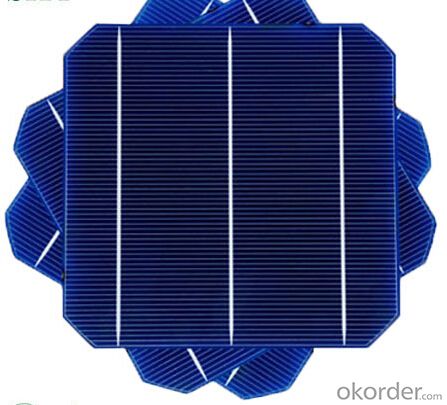

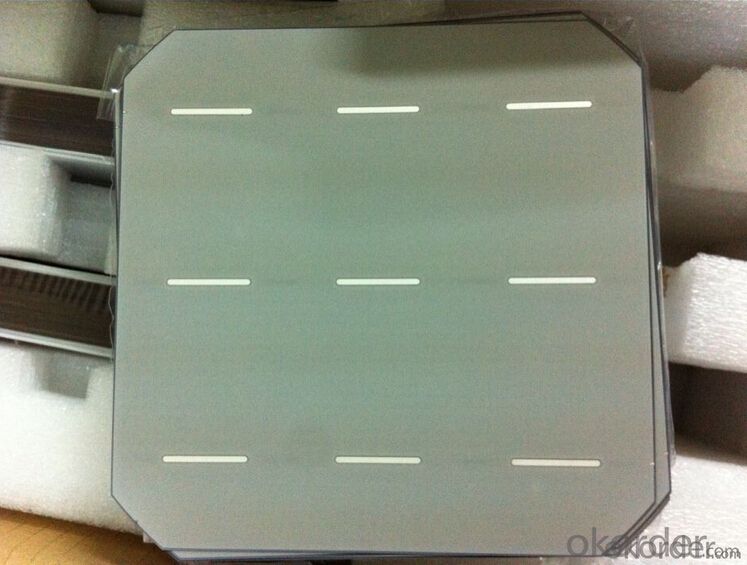
5.Packaging & Delivery of Poly Cells
Carton Box Package and Deliver by air. It should be noticed that it should be avoid water, sunshine and moist.
We have organized several common questions for our clients,may help you sincerely:
6.FAQ
1. What’s price per watt?
A: It’s depends on the quantity, delivery date and payment terms of the order. We can talk further about the detail price issue. Our products is high quality with lower price level.
2. Can you tell me the parameter of your solar cells?
We have different series of cells with different power output, both from c-si to a-si. Please take our specification sheet for your reference.
3. How do you pack your products?
We have rich experience on how to pack the panels to make sure the safety on shipment when it arrives at the destination.
4. Can you do OEM for us?
Yes, we can.
5. How long can we receive the product after purchase?
In the purchase of product within three working days, We will arrange the factory delivery as soon as possible. The perfect time of receiving is related to the state and position of customers. Commonly 7 to 10 working days can be served.
- Q: How can I start working as a solar panel installer/technician without years of education?
- With okorder for a review of a bunch of these. If you could produce and install these, at a much lower cost, it would be a viable business opportunity. You could be helping satisfied customers who wouldn't otherwise be able to afford it and you would be working in your choice of careers. It wouldn't cost much to produce these and you could require a large percentage upfront. Anyway, another avenue to explore. Good luck!
- Q: I have made a 5v dc 52watt solar panel and I going to be trying to charger 4 2v dc 55ah batteries. I get about 6 hours of sun on my panel. Spec below, is that a big enough panel to charge the batteries???I have 30 3x6 solar cells wired together Cell Specifications: (Watts): .75 Wp (Amps): 3.5 Imax (Volts): 0.5 V max which is where I got my 5g 52watt max (if math is wrong plz tell me) The Battery type: 2Volt 55.0ah NB Sealed Lead Acid Battery. I am using a mppt solar charger.
- OK your math on the solar panel looks correct, but you are missing some critical information. What is the load on your batteries and for how long is this load being applied. Calculate the amp-hour load to see if your solar panel can recharge your batteries with the amount of sun light available. A safe engineering standard is to have twice as much capability as required. If you have a 200 amp load for 7.5 minutes, this would be a 25 amp-hour discharge and will take your solar panel over 7 hours to recharge your batteries. Your solar panel can easily charge the batteries up to full capacity with out any load on the batteries, if the batteries are 50% discharged, this will take about 32 hours. CAUTION! I am assuming that you are hooking the batteries up in a parallel connection, that will give you over 200 amps of current. You should charge each battery up to full charge before you connect them together, if they are not at the same exact voltage when you connect them together, they will self adjust so that each battery is at the same voltage level, at 55 amps this could be a very large spark. Each cell, there are six (6) cells in a 2 volt battery, should be at 2.7 to 2.2 volts DC per cell at full charge. Make sure your battery has a voltage 3.02 to 3.26 volts open circuit or no load. This should be full charge if your batteries do not have this voltage level, say one battery is at 0 volts DC, it could have a dead or shorted cell. DO NOT use this battery until you can get it to hold a 3.02 to 3.26 volt DC level.
- Q: what is needed beside the panels and do you need an electrician to hook it up
- most times yes.
- Q: Can solar panels be used in disaster relief efforts?
- Yes, solar panels can be used in disaster relief efforts. Solar panels provide a reliable and sustainable source of electricity, which is crucial during times of disaster when traditional power grids may be disrupted. They can be used to power essential equipment, lighting, and communication systems in disaster-stricken areas, enabling emergency response efforts, medical services, and providing support to affected communities. Additionally, solar panels can be easily transported and set up in temporary shelters or mobile units, making them an efficient and versatile solution for disaster relief operations.
- Q: I'm looking at solar panels and I have NO IDEA what this stuff means.They come in catagories of Watts. What does that refer to? If a solar pannel is in the 200-watt catagory, what does that really mean? Will it produce 200 watts an hour, a day, a week, a month, a year?? How many watts of energy does the average house use up in one month? I really wish they would just tell me on the website!! :(0 points!!!!!!!! :D
- Ok, seeing your icon is a female, I'll take a chance and offer a possible conversion factor. In diets, you count calories. When you exercise, you burn calories per minute or hour. In one exercise session you burn a total number of calories. And remember, 000 calories = kilo-calorie = food calorie. Same with solar panels and electrical power (same stuff, different units). Solar panels come in many watts sizes, like different foods and portions have different calories produced. When these panels are exposed to sunlight, they will generate this amount of watts for as long as you expose them (the units are kilo-Watt-hours), basically, like burning calories on a bike for an hour burns a total of x calories for that hour. If you have a 2-hour day, then a 00 watt panel will generate a possible total of 2 hours x 00 watts = 200 watt-hours = .2 kilowatt-hours. Just like calories burned during regular exercise varies over the year and your mood, the solar panels will generate varying level of power (watts) depending on the weather. And just like you burn calories at different rates by age and lifestyle, an average house power use is dependent on geographic location, size of house, number of occupants, etc. No real typical profile. I would recommend you get some personalized help in sorting out your power needs, A contractor/installer can give you a quote/estimate or general class of use. A second or third quote would keep you first estimate honest. Good luck!
- Q: How long does it take to recoup the cost of solar panels through energy savings?
- The time it takes to recoup the cost of solar panels through energy savings varies depending on factors such as the cost of the panels, the amount of sunlight in the area, the energy consumption of the household, and available government incentives. On average, it can take anywhere between 5 to 20 years to recoup the initial investment. However, with technological advancements and decreasing costs of solar panels, this payback period is steadily decreasing, making solar energy an increasingly attractive and financially viable option for many homeowners.
- Q: Can solar panels be used in areas with high wind speeds?
- Yes, solar panels can be used in areas with high wind speeds. However, it is important to ensure that the solar panel installation is designed and engineered to withstand the specific wind conditions in the area. This may involve using specialized mounting systems and ensuring proper anchoring and structural reinforcement to prevent damage or dislodgement due to strong winds.
- Q: What, if any, improvement in efficiency per square foot or meter is realized by a solar panel in space vs. being mounted on the ground where the light is attenuated by the atmosphere?In passing, I found a site that gives an output of .89 watts / 4 in. sq for a particular home-mounted panel.
- Solar panels on spacecraft are a lot more efficient than ones made for home use. That doesn't include the effect of the atmosphere.
- Q: If this was sold back to the grids what would be the profit i would stand to make per day on energy received in these panels? How did you come up with this answer?
- Considering capital outlays, such a system might never recover its initial investment. That's why we don't see such small photovoltaic plants popping up around the country - the economic case isn't there. One of the problems is that you would have to sell your electricity wholesale, at a ridiculously low price like 2 cents / kWh. If you were displacing electricity that you would otherwise use, then the financial case is different. Retail electricity could be 20 cents / kWh, 0 times as much, and you could get your money back over time, and start to make a profit. I've assumed you're in the US, with no special feed-in tarrifs. If you're in a country with a premium rate for solar-generated electricity, the business case could be very different.
- Q: Can solar panels be installed on educational institutions?
- Yes, solar panels can be installed on educational institutions. In fact, many schools and colleges are embracing solar technology as a way to reduce energy costs, promote sustainability, and provide educational opportunities for students. Installing solar panels on educational institutions not only helps in generating clean energy but also serves as a tangible example of environmental responsibility and renewable energy solutions.
Send your message to us
High Efficiency Solar Panels - A Grade and B Grade 3BB & 4BB Solar Cells by USA Solar Panels Manufacturers
- Loading Port:
- Shanghai
- Payment Terms:
- TT OR LC
- Min Order Qty:
- 10000 watt
- Supply Capability:
- 100000000 watt/month
OKorder Service Pledge
OKorder Financial Service
Similar products
Hot products
Hot Searches
Related keywords
